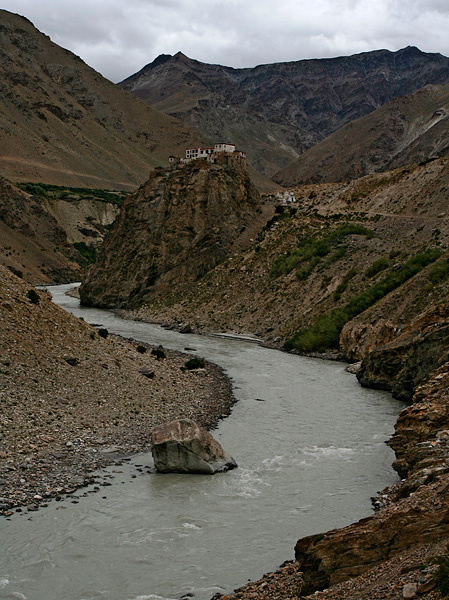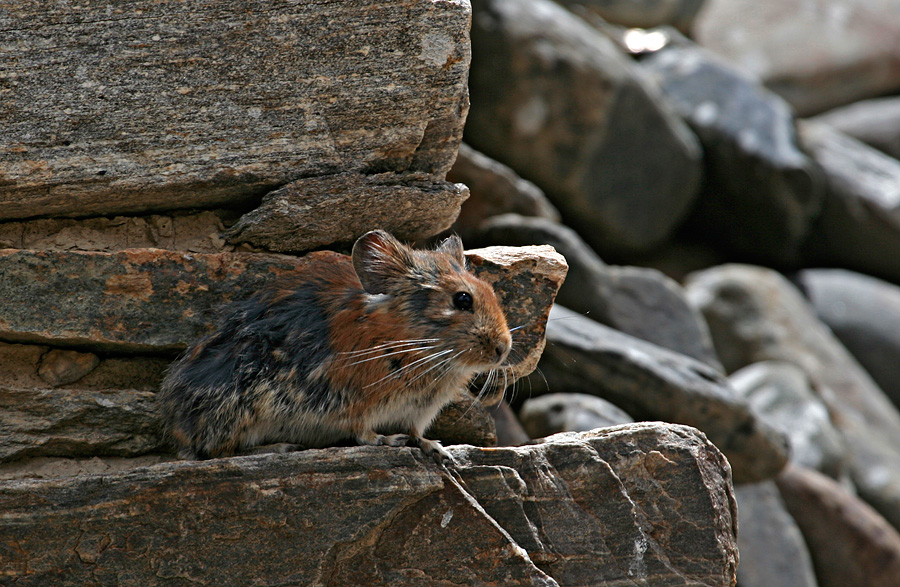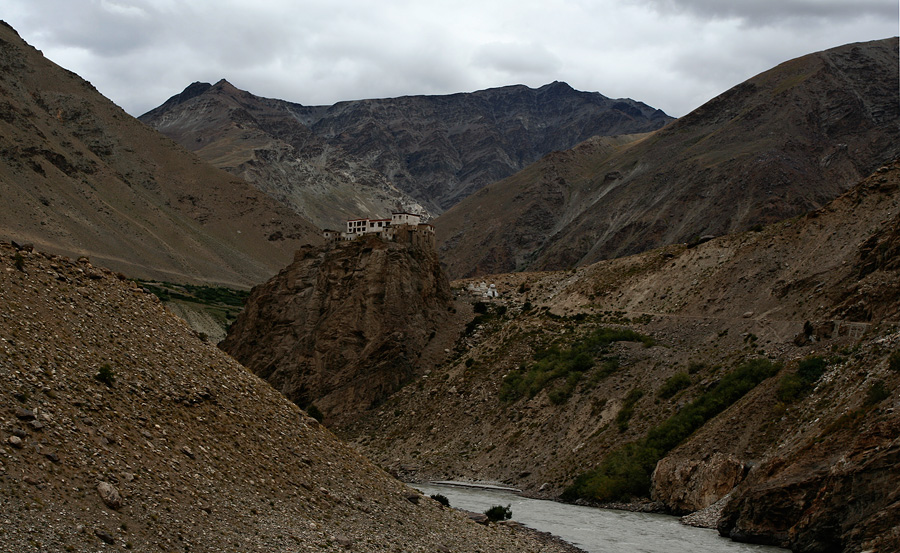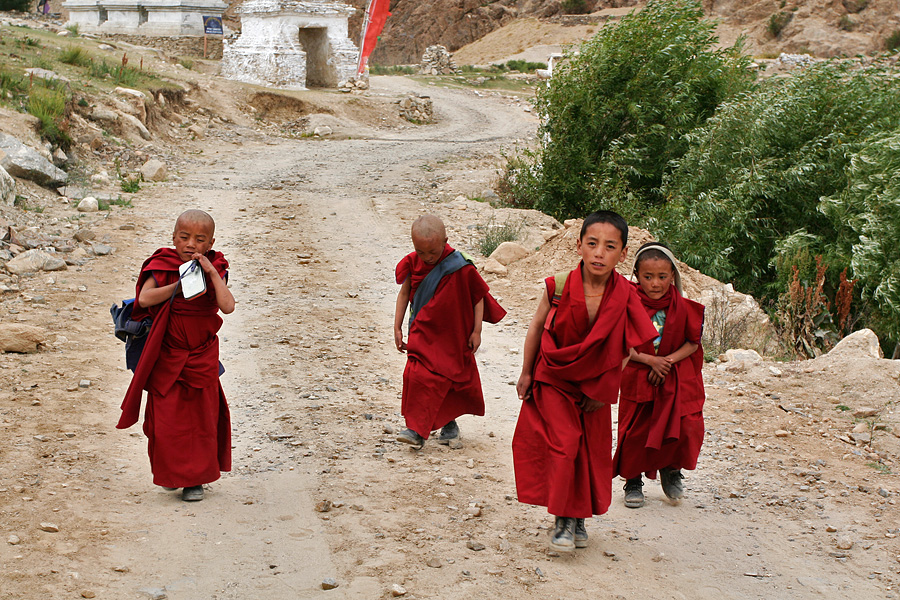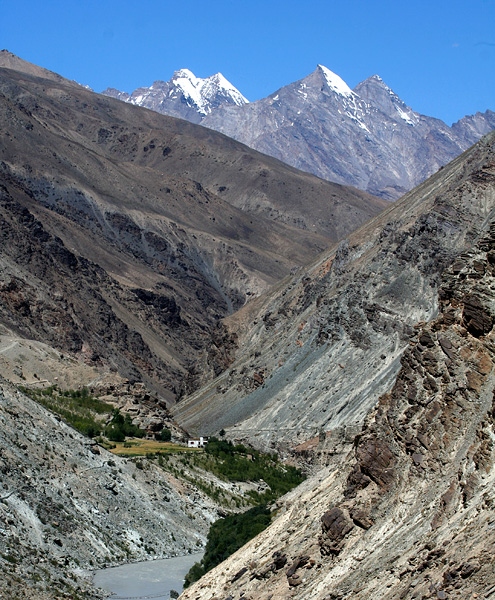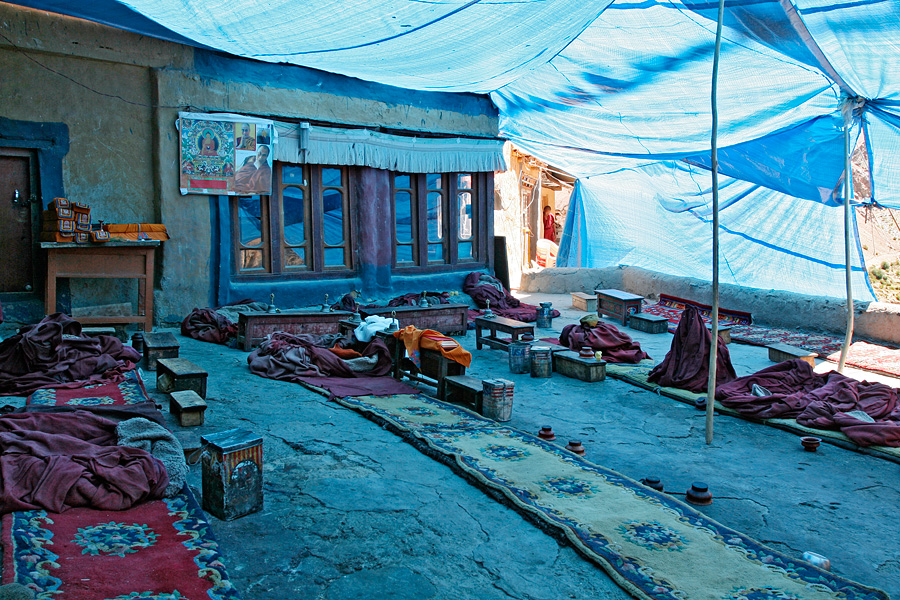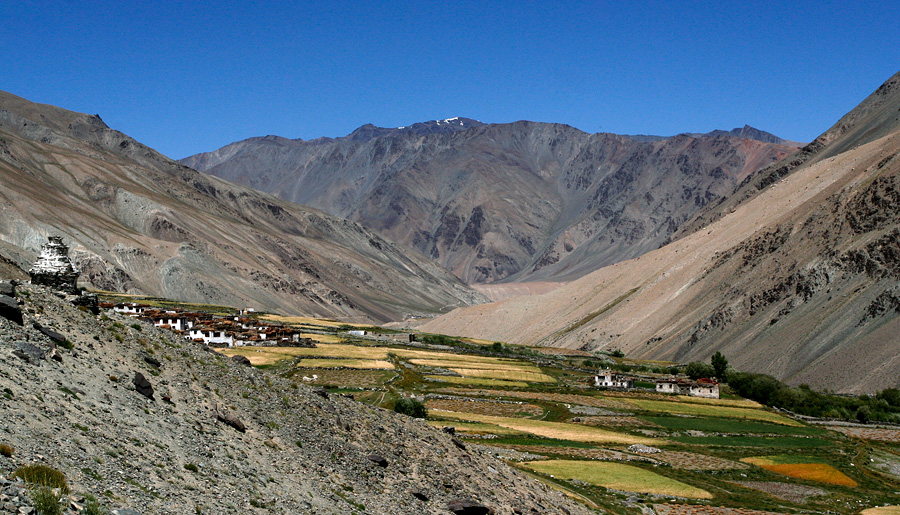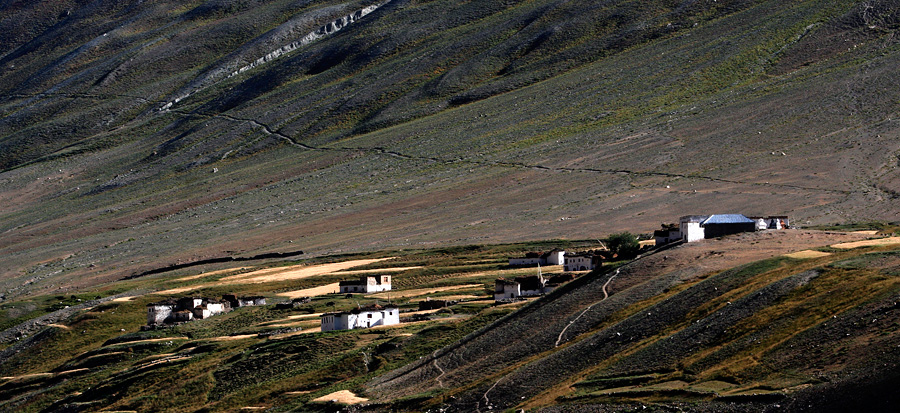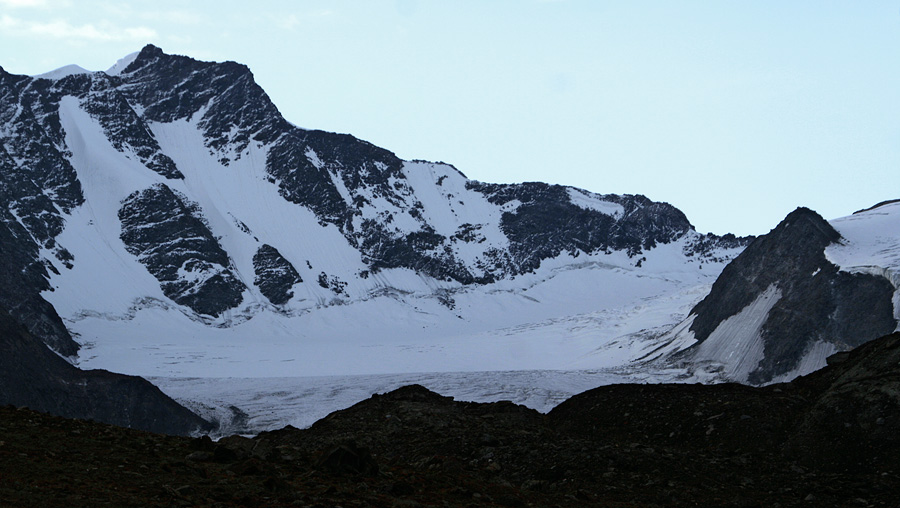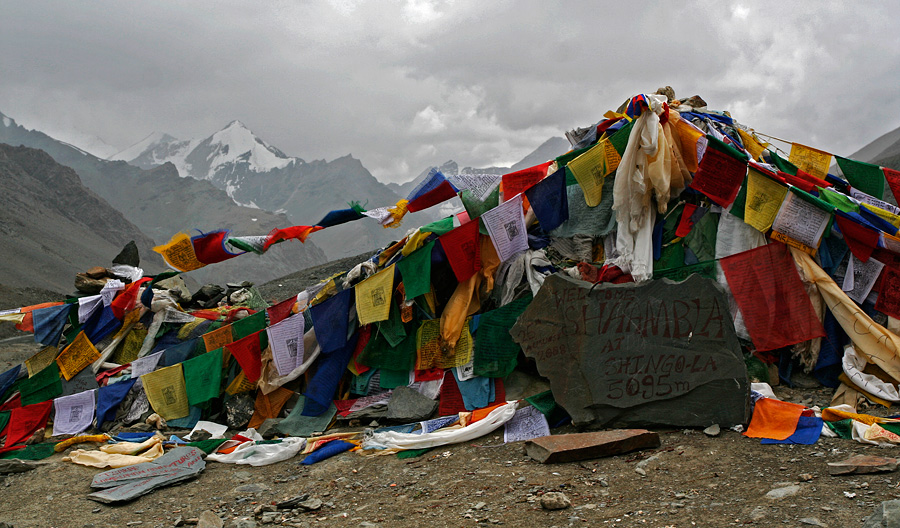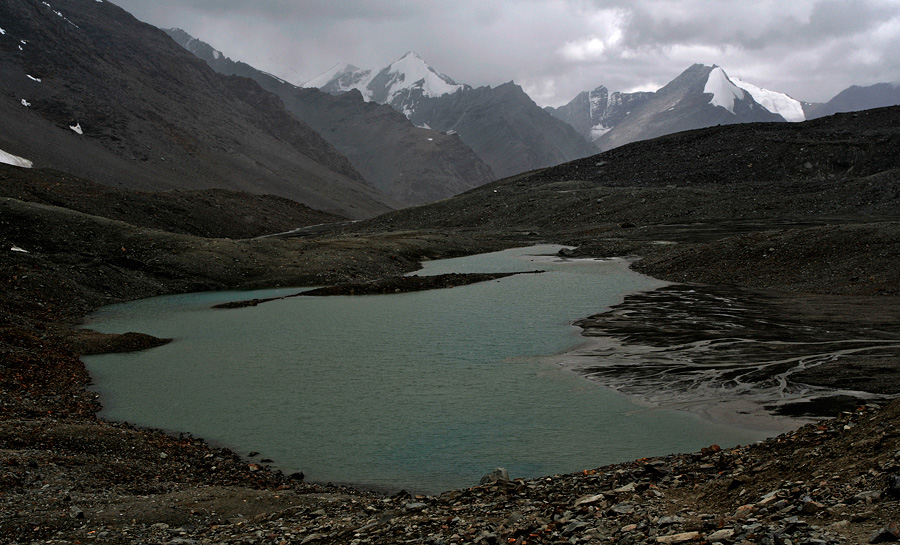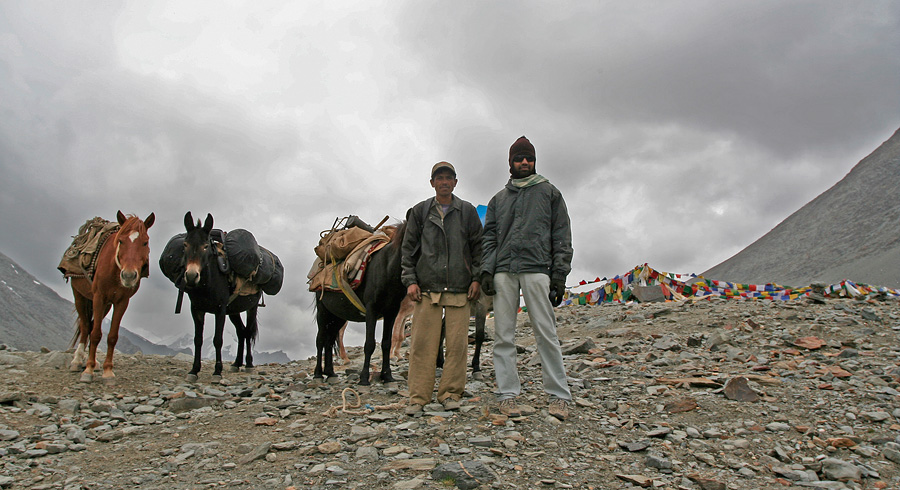Padum to Darcha Trek in Ladakh and Zanskar Region
In the summer of 2008, I travelled extensively in Ladakh spending two memorable months in the mountain country. Then, I had quit my corporate job a few months ago and was enjoying my time seeing the country. I travelled on budget, taking public transport as much as possible and living in home-stays in the villages. At the end of my trip, I exited Ladakh by making a two day bus journey to Padum in Zanskar and then making the nine-day trek through the mountains that led me to Darcha in Himachal Pradesh. The duration of Padum to Darcha trek is reducing every year, with a new motor road in the making I maintained a journal for much part of the journey to Ladakh, including this trek. Here a detailed trek-log, much of it taken as-is from the journal.
Padum to Darcha Trek
The road to Darcha goes along Lungnak River, steadily climbing up until the river’s origin near Shingo-la Pass. We begin from Padum on an unmetalled road, under construction from the venerable Border Roads Organization. Some day, when this road is ready, the entire stretch of our trekking route will be replaced by a highway that will probably be just wide enough for a vehicle to pass. But that’s just how Himalayan Roads are. The trek-route will be defunct then, so there is a sense of urgency in doing it now.
It’s a smooth walk from Padum along the road till we reach Bardan, the next village on the way. There are a few streams breaking the path that disturb the monotony of walking on the road. At Bardan, a monastery dominates the village landscape, standing on a crag at the end of a smooth curve of the river. Beyond the monastery, the mountains plunge into a deep gorge carved by Lungnak River.
Bardan Monastery and Lungnak River
Just before the arriving at monastery, I see a tiny rodent that runs pasts me into its hiding in a wall built from rocks. I wait for it to come out, keeping my camera aimed at its hole. It sure does, carefully checking out for enemies from its safety. I take a few pictures, which later help me identify it as a Himalayan Pika. A few minutes of walking later, I encounter a white rumped swallow-like bird and a red-tailed bird, neither of which I am able to name.
When I reach the front gates of the monastery, I am stopped by a man shouting at me from behind.
“Where are your people?” he asks.
“They have gone ahead,” I respond.
The next question follows immediately, in a slightly demanding tone. “Where is your ID? Passport?”
This surprises me first, and then I notice that he is drunk. I keep calm, a trait I have acquired from local people in my six weeks in Ladakh. But I do not know who he is and have no intention to show my ID to a demanding drunk stranger on the road.
“I don’t have an ID,” I told him, “I’m an Indian National and I don’t need to carry my passport around.”
The emphasis on Indian Nationals was important here, as nearly every person who treks in this route appears to be from the western world. During my two days of stay in Padum, I do not recall seeing any travellers of Indian origin.
“Who said Indians don’t need an ID,” said the stranger, this time even more demanding. Finally, I realized he is cop in plainclothes, manning a check-post nearby. The check-post is just a make-shift tent to shelter from the sun and there were no signs that asked travellers to report with them. I then show him my driver’s license, which he reads from end-to-end as if he is about to unearth a major fake-id racket. But the encounter has a happy ending as he scribbles the details in a shabby register and I move on.
Harvesting Barley at Mune Village
It is more or less monotone landscape–brown mountain slopes–until I reach the next village – Mune. I am now walking high up the valley, Lungnak flowing somewhere far below. The first views of Mune are of a monastery followed by a tea-shop that remained closed. August was already late in the season and trekkers facilities in the villages along the way were slowly shutting down. Mune is a pretty village–a clump of houses surrounded by barley fields located almost a hundred meter below the high-road. The river has disappeared in the steep gorge it is flowing through. In the fields, summer’s crop of barley is ready for harvesting and will feed the village for rest of the year. Half the fields glows with the golden-yellow crop bent in the direction of wind, while the other half is already harvested and laid in piles waiting to be taken home. The fields have strangely shaped boundaries–oval, round, leaf-shaped, heart-shaped and every kind of smooth contours you can imagine–perhaps governed by the way mountains are sloped.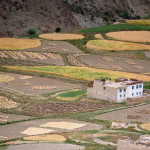
I am joined by four urchins in monks’ robes as I walk further. They are constantly chattering between themselves. I try to join the conversation, but we don’t speak any mutually comprehensible language that keeps us limited to exchanging ‘julley’s (‘greetings’ in Bhoti, the language of the region). Nevertheless, it is a pleasure to simply watch them talking to each other animatedly with little care about anything else around them. One of them bursts into smiles followed by long excited shouts every now and then. I can’t guess what they are trying to talk to each other. Another one is loudly rehearsing the days lessons, singing ‘A… B…C… D…’
I choose to watch and walk behind the boys. One of them, who has trailed a little behind others, slips and suddenly falls on the ground. Before I reach him and offer a hand, he is already back on his feet and moving ahead happily. The naughty bunch decide to let the road be and climb on a narrow platform at the edge of the road, built to prevent landslides. One of them gives me a curious look as I aim the camera at them.
Campsite at Raru Village
I leave the boys behind as they make their detour towards the village. The walk ahead is quick and easy in a relatively flat stretch of the road. I reach our camp site in Raru Village well before dark, where our horseman Brij Lal has already setup a tent. The campsite is a pretty place next to a small stream in a patch of lush grass sandwiched between a pond and a grove of willow trees. The silence here is absolute, bar the gentle gurgles made by the stream. The greenery around is a beautiful contrast to the brown mountain landscape we are in. Distant mountains to the west have shreds of snow on the peaks. I am happy to be here for the night, sleeping in a small make-shift tarpaulin tent in a sleeping bag pretty much under the stars.
We had begun this trip on a budget, making most of our preparations including buying tarpaulin at Padum. At the end of the trek, the tarp sheet would be go to Brij Lal who could do with upgrade to a new one.
Earlier, we had spent two days in Padum looking for people who can take us across to Darcha. We had first asked a trekking agency in Leh to help us with this trek. They were candid about the expenses of carrying everything from Leh and suggested that we look for someone in Padum instead. In Padum, the only agency with a shop-front quoted a price that we weren’t keen to pay. Thus began our search to self-source everything needed.
The first thing we needed was a horseman who can come with us to take our bags. We needed two horses: one would take our big packs and the other would take kitchen and tent equipment. This search turned out to be easy. A very helpful elderly person, who had no other intent but to help both horsemen and trekkers, found Brij Lal for us.
Brij Lal is a horseman from lower regions of Himachal Pradesh. He took his four horses to Lahaul every year, primarily working them in transporting sweet-pea and potato crops from the fields deep in the mountains to the nearest road. Whenever he gets hired, he would also take the horses on treks, primarily in Darcha-Padum-Lamayuru section. He had just come to Padum from Lamayuru, and was looking to go back to Himachal before the weather turns bad and passes close for the season. We had found each other in good time. He had four horses and we we needed just two. He agreed to charge us for two. He doubled up as our guide and cook as well and was offered a fee that is much higher than what a trekking agency would have paid him. At the same time, it was an excellent deal for us as we would be spending only a third of what we would pay an agency.
Subsequently, we had to hunt for groceries and equipment for the trek at Padum. Brij Lal already had cooking material but needed better housing for the trek. We bought large sheets of tarpaulin material that served as a tent to keep the cold outside. Next thing to do was buying groceries for the way, which turned out to be an ordeal. Most shops in Padum weren’t well stocked. The grocer who had rice would not have wheat. The guy who sold wheat did not have lentils. Even a few people who had what we wanted showed us grains of very poor quality. What we thought was a simple task of going to one shop and getting everything, turned out to be quite a task. In the process of moving back-and-forth for groceries, we discovered that some shop-keepers are hoarding stuff and not selling their stock, for reasons we did not know. The owner of the hotel where we were staying came to our rescue. She came with us and demanded that the shopkeepers open up their stock, ensuring that we got all the supplies.
(Day 2: Raru to Ichar)
I wake up early to savour the peace and freshness of the morning hours. Golden light of the morning sun fires up the mountain peaks, which in turn reflects in the calm pond surface. It’s cold at the campsite and it would take hours for the sunlight to reach where we are. We take our time to get ready, pack all the stuff and get going, passing through Raru Village. Raru is at a wide open section of the valley with a large plane area the size of several football grounds,a rarity in this mountain region. There is a large school built at the edge of the plain, supported by a German organization. We walk past the school and rest of the village to arrive at a roaring stream that will be bridged some day for the vehicles. The road, however, has been built well past the stream, and it takes another thirty minutes of walking before our track converges into a small path. Every year, road workers will gain some more distance and the trek is bound to get shorter. We had seen no more than half-a-dozen BRO trucks during our walk yesterday, but it is still a relief to know that we are now beyond a world of traffic. It would be another week before we see motor roads, vehicles and electricity again.
Now that the way isn’t made with brute force by cutting the mountains, there are plenty of ups and downs to take care of. At many places, we are walking close to the river, almost skirting the bank. Whenever the river disappears into a steep gorge, the pathway goes up the hill and comes back again near the river, exhausting me in the process. At times, we are walking on a path just wide enough to hold a person. These narrow stretches are often on scree slopes where you end up pushing some stones down to the river with each step. Slipping a few inches or a bad step can take you down the valley in no time just the way those stones were going down.
The next village on the way is Ichar, reached after two and a half hours of walking. There is plenty of greenery around the village and snowy peaks dominate the landscape here. Somewhere up in the hills isolated from rest of the village is a structure, probably a monastery.
Just before Ichar, Lungnak River, which we have been following all through the trail, makes a beautiful ‘U’ bend as it goes round a rocky hill. I stand at the center of the semi-circle and quietly watch the sensuous curve and the smooth flow. Further, in places where small glacial streams come down the slopes and join the river, there is burst of flowers in deep pink, yellow and white. I try to pull out a few seabuckthorn fruits and enjoy the sourness of the ripe fruit. But the plant doesn’t like me stealing its produce and pricks me with its thorns.
The day’s camp will be setup at Peepul Village, a small and dirty campsite right next to the roaring river. We do not like the camp and wanted to move on to the next village, but our horseman Brij Lal prefers this place. He is more likely to find some fodder for the horses here, than at the next village.
(Day 3 & 4 – Peepul to Purne)
The villages along the way are all green, adding a dash of colour to the otherwise brown mountain landscapes. Just after we begin the walk from Peepul, we have to make a steep climb and cross a deep gorge made by what is now a small stream with very little water. It would have been a strenuous hike to the top of the gorge to cross it, but is thankfully cut short by a wooden bridge at a narrow stretch. It is so deep down the bridge and is so dark at he bottom that I can’t see where the stream disappears.
Much of the walk today has a lot of climbing up and down on paths barely wide enough for two feet. Complicating this is frequent encounters with horses along the way, for whom you have to vacate a part of the path, gluing yourself to the mountain side and desperately hoping that they don’t kick you.
Most villages we pass by today are located far from the path, either high up in the mountains or on the other side of the valley. One exception is Kolbok Village, one of the few places where we walked right next to the houses. They even have a restaurant that serves trekkers, but is now closed as the trekking season is drawing to an end. But I can see their shop and wonder how well equipped the are–Coke, several other type of soft drinks, the omnipresent Maggi and a lot more stuff.
It was around 2pm when we crossed Lungnak on a sturdy bridge and arrived at Purne. Purne is at the confluence of two rivers–Tsarap and Kargyak (Kurgiak). They come together to form Lungnak River here, which in turn becomes Zanskar River near Padum.
Purne is a three-house village, all of them doubling up as guest-houses for trekkers. The rooms we see could do some dusting, but it is still a welcome break from sleeping in the tent. And then, there was also chance to get a shower and feel fresh and clean. The nights would be warmer inside a house as well; much comfortable compared to our flimsy plastic tent.
We scanned our option from the houses available. One of the houses was closed as its occupants were out in the fields working. We simply settled for the next one that belonged to a middle-aged lady named Dolma. A group of Americans who arrived after us took the neighbouring house. We would realize later that ours was a bad choice.
Dolma likes to talk much and work less. By what I understood, and if my now six-year old memory serves right, she holds a government employment. Visitors would come to her and she would chat elections and administrative affairs for hours together without getting up. In the meanwhile, if the travellers staying with her wanted something, they can wait.
When I ask for dinner in the night, she was reluctant to make it. She says it would take very long to prepare.
“How long?” I ask.
“May be 7.30pm”.
It was perfect time for us and we indicated so. That unsettles her for a moment, but she immediately comes back to say it may take as long as 8.30pm. We understand that she just did not want to take trouble. We stop troubling her much and eat with the neighbours as much as possible. The neighbours are polite people. They are nice enough to suggest us first that we should consider eating where we are staying, but are happy to serve.
Next day, with the temperatures coming down as the day is about to end, I ask Dolma to make tea. She is sitting in her shop talking politics with her friends, but agrees to make tea anyway. Ten minutes later, when I remind her about the tea, she gives a shout to her daughter who is out washing clothes nearby. There is no response; either the daughter chooses to ignore the call or she hasn’t heard it. Dolma continues her conversation about local politics. Fifteen minutes later, I come back to check if the tea is ready. She responds saying ‘it is getting done,’ and finally gets up to fire the stove.
Our horseman has it more difficult. He has asked Dolma for grass for the horse. It is common for horsemen to buy grass from local people in this arid mountain region that doesn’t provide enough good quality fodder. Dolma quotes a price, which Brij Lal thinks is too high, but agrees to it anyway. The deal is done and now all Dolma has to do is to get up and let him take the grass from the storage. This of course, doesn’t happen for the next one hour as Dolma is too busy to get up. Brij Lal waits for nearly an hour, and reminds her politely. The same Dolma, who at least offers evasive answers to our demands, is extremely rude to Brij Lal.
We were victims of Dolma’s moods as well. Last night, Dolma shouts at us for leaving the blankets on the floor. “It’s a blanket, we never leave it down on the ground,” she says in a high voice, “if you do such things, I will take an additional five hundred rupees from you.” These precious blankets, once white in colour, had seen many unwashed years and had turned brown and muddy. We had decided to do away with them and use our sleeping bags instead. Instead of responding to Dolma’s rebuke, I just laugh loudly, enjoying what I would rather term as her innocence. Now, she doesn’t know how to respond to my laughter. That ended the troubles and she joins me in laughing, putting a happy ending to the day.
We would realize that Dolma had even lied to us about the price of accommodation at her neighbours’ place. She had mentioned when we arrived that her neighbours charge twice as much as she does, but it turned out to be other way round. As if that’s not enough, the neighbours had a better quality accommodation.
These were small incidences not strong enough to spoil my mood. Having spent more than a month in Ladakh, some of its good things have rubbed in and I have come accept things as they are and live with a smile. I have been having a good time in Zanskar and I was going to keep things that way.
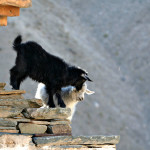 The family has a bunch of young boys who keep us engaged. One of them stand at the door and tries to mimic me. Another one has an intent and interesting gaze that is capable of making everyone grow fond of him. And then there are some pretty lambkins in the premises running all over the place, jumping over boulders, curiously smelling everything and checking out what is edible. I spend some time chasing them and trying to catch one of them, but they are extremely agile and too smart for me.
The family has a bunch of young boys who keep us engaged. One of them stand at the door and tries to mimic me. Another one has an intent and interesting gaze that is capable of making everyone grow fond of him. And then there are some pretty lambkins in the premises running all over the place, jumping over boulders, curiously smelling everything and checking out what is edible. I spend some time chasing them and trying to catch one of them, but they are extremely agile and too smart for me.
(Day 04 – Purne to Phugtal)
We will not be walking much on the fourth day of the trek. We will be taking a detour to visit Phugtal Monastery, a monastic establishment located in the middle of a steep slope facing Tsarap River. It’s an easy two and half hours walk along Tsarap, without too much of ups and downs. Crossing a bridge across Tsarap and going up a short, steep ascent, the monastery suddenly appears on the other side of a bend, as if the structure is desperately clinging to a mountain-wall, trying not to fall into the river.
In their bid to build monasteries at tough-to-access places, the people of Ladakh-Zanskar region have excelled in Phugtal like nowhere else. Located on a cave high up the mountain, it takes two to three days of walk to reach the monastery. For those who scan for the nearest airport for visiting a destination, Phugtal is at least four days away from an airport and a week’s distance from a train station. And one has to be very fit to be able bodied, without which it is impossible to reach the monastery. I had prepared well before reaching here – having seen the photographs and having heard about the superb setting. And yet, it is impossible not to gasp with awe at the first sight.
Phugtal Monastery and Tsarap River
The approach to the monastery is through a path that is wide at first, passing next to a few chortens. It narrows down a little ahead and is flanked by mani-walls (?), and subsequently a quick climb before reaching the cave.
Perhaps the monastery was limited to the cave once, but has spilled over to a few buildings on the slope now. The only part of the monastery that is still in the cave is a du-khang (prayer-hall). The old prayer-hall walls had developed some cracks and are now being re-built. While the construction is in progress, the prayer-hall is now shifted to a terrace, protected from the elements by a big blue plastic sheet. The make-shift prayer hall is simple, sans the elaborate decoration and painting that is common in the monasteries. All they have now are long carpets parallel to each other, meant for seating. Yet,I find this simple arrangement very appealing.
The monks here are genial and always open for a conversation. Most of the monk have aged, and smile gently with whatever teeth they have remaining. There is a sense of elevation just being with them, as though a bit of their goodness is transferred to me. A few young monks are sitting in the du-khang, reciting some mantra’s loudly. As is always the case with little fellows, their attention is every except on the recital. One of them smiles at me and invites me to sit next to him.
It is almost lunch-time, and they coax me into joining them. They wouldn’t let me go without eating, but I gently refused. It would have been a pleasure to join them in lunch, but I did not know how much food they could really spare in this faraway place. Perhaps they were flush with donations from local people or perhaps not, but there was no way of knowing and I did not want to be a strain on their resources.
Phugtal leaves me with a feel-good sensation. As I write this, suddenly I am overcome with the memory of those interactions, and there is a longing to be back there again.
(Day 05: Purne to Khi)
It is going to be a long walk today. Before we leave, we stock up some biscuits and packaged fruit drinks. It’s amazing how well stacked are the shops in these parts despite their remoteness. I found soft-drink bottles everywhere. There were chocolates, maggi and packaged mango drink and many more stuff that I never thought could be found so faraway. They bring goods on horseback from Padum and stack them up for the trekkers. Bless them! The prices are, of course, often thrice as much as the rates mentioned on the packaging. But you can’t complain when you can at least have them.
From Purne, we leave the company of Lungnak River and walk up hill on Kargyak Valley. The plan was to leave early, something that doesn’t happen often, including today. It was a steep climb to Yal, the next village. My legs have been expressing unhappiness since last two days, because of which I dreaded the uphill climb. But there isn’t much of a choice but to let them suffer. The reward comes after the effort – a gradual descent that helps me recover and keep moving.
Yal is a small village with no more than half-a-dozen houses and small barley fields surrounding them. It is August, but they are already getting ready for the winter. Roof of the houses is stacked with fodder for the sheep and cows. Plenty of cow dung has been left to dry at every house, which will be an important source of fuel in the cold months.
Just after Yal is a perfectly clear stream flowing gently down the mountains. Its foaming waters fall off from small rocks, making a soft gurgling sound that sounds like music at its purest. The brook is so pure and perfect, its current just fast enough to express its spirit without intimidating a passer, its presence so soothing that I pause for a few minutes to watch its flow. Seeing such perfection leaves me in an excellent mood and shoos off my fatigue.
Beyond Yal is Testha, perhaps the largest village that we encounter during the trek. The hamlet is a haphazard arrangement of houses and fields with the trekking path breaking through them all. Most of the village is busy harvesting the year’s only barley crop, which will help them sail through a long winter. There are small canals with water gushing through them, diverted from a stream to irrigate the fields as needed. The houses are all built in traditional style, with mud walls painted in white flaunting large windows. Karu, the next village is almost contiguous with Testha. The valley here is wide and has plenty of water available, allowing these settlements to flourish.
Further ahead, an hour and half from Karu is Tanzen, where we find a tea shop. Where there is a tea shop, you have to stop and rest. This also serves as a pit-stop to gobble our packed lunch. Beyond Tanzen, it is relatively flat terrain and walking is fairly easy for rest of the day. The evening will be at Khi, where we camp in a wide open valley and a green pasture adjoining the Kargyak River.
On approach to Khi, the valley widens considerably at the confluence of Kargyak with a small glacial stream. It’s a beautiful and picturesque landscape with patches of green grass in the lower slopes, the gently meandering stream emerging from the mountains and snow-peaks somewhere faraway to the west.
Gumburanjan Peak
The biggest treat of the day is to be seen soon after we cross this confluence, just before the place where we are about to camp. Walking across a bend, I am suddenly struck with a brilliant view of the giant Gumburanjan peak – a solid mass of rock forming a steep wall against the valley (also written as Gumbok Rangan, Gumburanjon). It’s face is almost vertical and allows no snow deposits to cling on despite its high altitude. The surging Gumpuranjan peak dominates the valley of Khi and shadows every other mountain around it.
This place is a paradise. There are snow-covered mountains on one side, green grass in the lower slopes, confluence of two rivers to the north and Gumburanjan looming large to the south. We could not have chosen a better place to camp.
(Day 06: Rest day at Ki)
After trekking for five days, it is time for a break. We stay put in Ki today, lazing and doing little. I wake up for the sunrise to watch the orange glow over the mountains, but soon retreat to the tent for an extended slumber.
Having camped right on the bank of the river, I can see how its mood changes. Yesterday, when we walked upstream in Kargyak’s Valley, the river appeared mild and friendly in the morning hours. By evening, with sun melting some snow on peaks, it had become an angry torrent. This morning, it was once again the mellow river that I remembered from the previous morning.
I can’t help but reiterate that everything around me looks beautiful today. Khi is a pretty village surrounded by greenery that is rarely seen in these parts. Kargyak is flowing gently, unlike most rivers here that always seem to be in a hurry. It is the most colourful sunrise in the two months that I have spent in these mountains. And there is Gumburanjan, which is so majestic that I can keep staring at it all day long. Most importantly, I am not walking today, but just sitting on a stone and gazing at all these beautiful things. I couldn’t have asked for more.
Unfortunately, it isn’t such a blissful experience for Brij Lal. His horses wander off in the mountains searching for fresh grass and he had to keep a look out for them all through the day. The people of Zanskar are not exactly friendly towards these horsemen from Himachal. Instead, they see a revenue opportunity in the transiting horses that wander away.
Khi Village
About eight in the morning, Brij Lal discovers that the horses are nowhere to be seen. He runs off in search of them, wanders all around the meadow for more than an hour and comes back with a worried look.
“Villagers may have tied the horses,” he says, and takes some cash from his wallet and walks towards the neighbouring Kargyak Village. It takes another hour for him to come back, now with the horses, but lighter by Rs.1,100 that he had to pay to get the animals released.
Later in the day, he gets complacent again and let’s his horses road free. Mistake. Some time in the afternoon, another horseman who was passing by shouts something and Brij Lal goes out running. His horses are out wandering again. They have crossed the river, which is now running low, and have wandered towards to Khi in search of grass. Brij Lal, unable to cross the river himself, tries to call them back in vain.
I am watching all this drama, when it suddenly takes an ugly turn. Seeing the horses cross the river, a woman comes down from Khi and herds the animals towards the village. And next to me Brij Lal watches this happen mutely and helplessly. He stands motionless, depressed about the money that he has to shell out again to secure the possession of his horses. Finally, when he realizes that there is nothing else he can do, he makes the long walk to the village across a bridge. It takes an hour before he comes back with the horses.
The incident leaves me distressed. When they were taken away, the horses were still lingering by the river, nowhere close to the fields. If I owned a farmland or even a grazing land and see some animals grazing anywhere close to the property, I would have only chased them away and perhaps warn the owners. It’s another matter if they had stepped into my field and destroyed the crop. But taking away horses that had not yet done any damage and demanding money to let them go? I think it is akin to kidnapping and demanding a ransom. I must say I don’t have the other side of the story from the villagers if there is one, but I surely do not like what I just saw. Wasn’t it easy to chase the horses back before they made any damages? Perhaps people of Zasnkar were long frustrated with the horses grazing in their fields before bringing in such stringent practices? I do not know. But we are in a place where villagers make their own rules. Brij Lal has no option but to pay up for a crime that his horses had not yet committed.
Brij Lal has more stories to tell about his displeasure towards people of Zanskar.
“They talk to a horsemen in a bossy manner in these areas,” he says, “but when they are in Himachal, they speak to you in a very soft tone (darcha me to ‘jee jee’ kar key pukarte hain). Here, if the horses go to their fields and cause even the slightest damage, they demand 4-5,000 rupees. It’s common to tie up the horses and demand money if the animals go anywhere near the villages.” He says all this with a smile, without an shred of bitterness about his sufferings.
But not all our experiences are this way. On the contrary, most of my encounters with the people here are friendly and hospitable in nature. Which reminds of my conversations with Stanzin, whom I had briefly met on the first day of the trek and again encountered on the third day near Purne. “You have made it so far,” he said in a friendly tone, “I have duty as policeman in Padum. We have local elections coming up, so I am heading back towards Padum now”. I smiled nodded in response. He invited us to his place before parting, “My house is in Khi. Do stay at Khi on your way. You can eat and have tea at my place. Have a good time ahead!”
This hospitality from strangers is not uncommon. A few hours later, I speak to a man who overtook us on the path. He smiled brightly and said, “do you recognize me? I was in the bus with you in Padum.” He is from Yal and insists that we visit his place for tea.
Most people I meet during the trek are genial and welcoming. The local horsemen whom we encounter walking in the opposite direction helpfully tell us about the way ahead. Monks speak to us in an assuring tone full of tenderness, their eyes glowing with compassion. These are people who keep my mood from sinking due to those few unfriendly encounters.
Fellow travellers enliven the journey as well. As we were late in the season for trekking this route, I was expecting to see very few travellers along the way. But the route was still fairly populated and we always ended up camping along with another group or two.
The first ones I meet are an elderly couple from Germany, on their way to Manali. They had chosen a hard way to get there from Leh, starting a long walk from Lamayuru. They were already walking for two weeks and it would take them another week to reach Manali.
A small group with a mix of American and Japanese Nationals walked along with us on the first three days. They were a jovial lot and also very strong folks who carried all their luggage on the back, without relying on horses. Not that they preferred it that way, but weren’t able to find any any horsemen willing to go on their route up the Phirtse-La and down to the plains of Sarchu on Manali-Leh highway. They don’t even have a guide to show the way and have largely relied on maps and asking around local people. But they are well equipped to handle any trouble, both in terms of stuff they are carrying as well as their own physical abilities to face the mountains. One of them, Jeff, was a veteran of Zanskar-Ladakh and had first visited here more than twenty five years ago.
“That was just when the road from Kargil to Padum was built,” he says, and his wife laughs and adds quickly, “and the road has been in the same condition since then.”
Most of the trekkers we see are from the western world. The trek-guides we meet on the way say that Indian Nationals, even when they come, rarely complete the trail. I wonder why, because this is not a tough trail. I do not consider me very fit and would not attempt a trek that has a high level of difficulty. Perhaps it is the need for time time. As I have seen, most Indian Nationals are unable to keep away from their workplaces for long. Another guide says, “Indians come on their vehicles till Rohtang Pass and go back.” The scenario, however, is changing.
Indeed, we hardly encounter any Indian Nationals, except a group of very fit men who came from Nasik and a Sardar from Ludhiana. I struck conversation with the Sardar, whom we meet at Lakang Sumdo, travelling in the opposite direction. He is a veteran of the Himalayas and goes on a long trek at least once a year. He thinks of me as a novice (which I am) and offers helpful advice on making it to Shingo La next morning. His cautious approach only instills some fear of the next day’s hike, but it turns out to be a fairly easy crossing.
(Day 07: Khi to Lakang Sumdo)
Much of the walk today is through a wide valley in a relatively flat terrain. Brilliant views of Gumburanjan keeps my company, its steep north face appearing taller and larger with every passing mile. Kargyak is the next village on the way, just twenty minutes from Khi. This is the last village on our way before we leave Zanskar-Ladakh to climb a high pass and get down to the valleys of Himachal Pradesh.
A little after 2pm, we are in a large bowl of a landscape in the foot of mighty Gumburanjan. I need to crane my neck to see its 5320m high peak. Several nomad families have camped here to take advantage of abundant grazing grass in the valley. There are yaks, horses and a smaller number of cows. I watch the adorable yaks with their thick furs grazing peacefully near the river-bed. Some of them walk into the flow of water and stand against the flow, unmindful of the near-zero temperature of the glacial waters.
There is a muddy, fast-flowing stream joining Kargyak River, probably originating from a glacier on the south-face of Gumburanjan. We need to cross this to continue to the campsite at Lakang Sumdo, but the waters appear too fast for safe crossing. As the current is brown, I can’t even assess how deep this is. Brij Lal insists that it should not be a problem, but he is busy tending to his horses instead of leading the way. As I ponder about my option, the German couple who were travelling with us arrived, quickly assessed the depth of the stream with a stick and were on the other side in no time. But the stream looks so angry, I am still not certain. They wave at me to come along, but I am not ready yet.
Now, it is Brij Lals turn. He has tied all the luggage properly on the horses and now lets them cross. As the last horse is about to get to the water, he suddenly jumps on it and fords the stream on its back. Before I can react, he has reached the other side and is asking us to cross quickly. This is cheating! Since I am still unsure about crossing by foot, I now know what to do. Brij Lal is made to come back with another horse and help us get across. These animals, although they appear feeble, are really strong and sturdy. One of the horses effortlessly gets me across, as gracefully as it would walk on plain ground when there is no weight on its back.
Beyond this, the path goes along the river bank to the right and the giant wall of Gumburanjan to the left. It is initially boulder-strewn and is full of pebbles when it descends to the river bed. It is nearly 5.30pm when I reach the day’s campsite at Lakang Sumdo. This place is cold, which is worsened by occasional winds. The peaks seen from here have large piles of snow, indicating that this area is colder than the places we walked past. I can see a massive glacier to the south not too far from our came, from which Kargyak River flows down.
(Day 08: Lakang Sumdo to Ramjak via Shingo La)
It was a cold night at Lakang Sumdo that made me wake up early. A walk outside revealed that it was sub-zero temperatures during the night. A thin layer of frost had formed over small streams around the camp. Water level in Kargyak–now already much smaller than what it is in Purne–had gone down considerably. The clouds did not allow the sun to come up and the temperature stayed low until we removed camp around 9am.
The path climbs quickly and steadily from Sumdo to Shingo La pass. The pass will be the highest point in this trek at nearly 17,000 feet. My body can feel the lack of oxygen at this altitude, so the climb has to be slow and steady to avoid fatigue. The climb gets steeper as we gain altitude, further reducing my walking speed. At two-thirds distance to the top is a permanent snow-field over a stream, indicating that we are in a region that gets plenty of snow and the temperature remains low all through the year. This is the first time I am walking on snow in this trek. Soon after this, we encounter our first snow fall as well. Thankfully it is not a heavy precipitation.
Shingo La
Shingo La is full of ice. There are at least three glacial sources of water emerging from the mountains around the pass. One drains towards Kargyak, other towards Darcha and a third one whose waters flow into both sides. The flow towards Kargyak emerges from an ice-shelf that is almost twenty feet high. The melting ice forms a shallow pool on the other side of the pass.
We have arrived here in bad weather. The sky is dark and we have been seeing occasional flakes of snow falling down. Even in this bad weather, Shingo La is majestic and beautiful. There are massive blocks of ice everywhere around us. Snow peaks are very close, at a short but dangerous walk over the hard ice. Standing on the top, I can see Gumburanjan at a distance in the direction we came from and several snowy peaks on the other side.
Weather gets worse once we begin our descent. Snowing gets heavier, and as we descend, it’s a mix of rain and snow. Thankfully, the temperatures on this side aren’t very low and there isn’t too much of discomfort. We reach Chumi Napko in a drizzle and rest in one of the kitchen-tents of a trekking group going in reverse direction. The Himalayan hospitality experience kicks in as soon as we step into this tent. The staff of the trekking group immediately invite me to rest and offer us some tea. Bless them!
Yours truly with Brij Lal, horseman + cook + guide for this trek, at Shingo La.
There was still a lot of time for the day to end, and we continued to walk towards Ramjak, the next camp site. The way forward from Chumik Napko is full or rocks and walking among them is painful. Although it it’s a descent, walking on this rocky path is slow. The slopes in these parts are not steep and dangerous as they are in Zanskar Valley, but one may easily sprain the ankle trying to walk on these stones. We arrived at Ramjak when it was almost dark, after a day of long and tiring walk.
(Day 09: Ramjak to Darcha)
Generally recommended trekking itineraries suggests that you cross Shingo La to camp at Chumik Napko, and subsequently spend another night at Zanskar Sumdo before reaching Manali-Leh highway at Darcha. Since we had covered additional ground yesterday, we contemplated walking to Palamo, a village further down the path.
Zanskar Sumdo was a little more than an hour’s distance and we covered ground quickly. Beyond Zanskar Sumdo is a boulder-strewn landscape without a path, where it takes painfully long time to hop-on and off the rocks to cover the distance of a kilometer. We are greeted by unmetalled BRO road soon after the boulders.
After walking up and down the steep slopes for a week, walking on the road is a breeze. Instead of camping for another night, we stride past the villages of Palamo, Rarik and Chika to reach Manali-Leh highway at Darcha just before darkness fell. We had reached Darcha in good time for the last bus that could take us to Keylong. That night was blissful, where I was reintroduced to the pleasures of a warm room, hot shower and a cozy bed.
Also see: Trekking route mapped using Google Maps
Padum to Darcha Trek Information: Logistics & Preparation
If you are travelling from Darcha to Padum, trekking agencies in Keylong can help organize the trek for you. If you intend to do it on your own without the help of an agency, you may have to look for horsemen on arrival at Darcha. I am not sure how easy it is to find them. Darcha is a small settlement and finding groceries and other materials needed for the trek here can be hard. Do all your shopping in Keylong.
For those who do the trek from Padum, it shouldn’t be hard to organize everything on arrival at Padum, whether you want to go with an agency or plan it on your own. Padum may not be the best place to shop for things needed on the way, but you will manage to find everything you need with some difficulty.
Porters are usually not be available on this trek route. Either you carry your own stuff or hire horses to do the job.
Except between Kargyak (in Zanskar) and Palamo (in Himachal), you will find villages all along the way, where you will be able to camp. Even between these two places, you may find parachute tents to sleep and eat in, at Lakang Sumdo. You may even be able to replenish your stock of maggi, chocolates and other processed foods along the way, but it may be better to start fully equipped than gamble on it. I have known local people travel the entire distance with just a day-pack and staying with villagers, but trying something like that would be risky for an outsider if the weather turns bad.
Purne has three guest-houses well-equipped to accommodate trekkers. It could be a good stopover if you are craving for a shower. You may be able to find accommodation with villagers elsewhere, but that’s something I haven’t tried out.
The weather begins to play spoilsport in this region at the end of August. So it is recommended to do the trek between early July to mid-August. If you can handle the bad weather, the trek-route may be doable as far as early October.
If you are short of time consider hiring vehicles at both ends of the trek as far as the road goes. But these places are a pleasure to walk, especially so on the Zanskar side of the trek.
This video gives you better insights on how beautiful the trek is.
